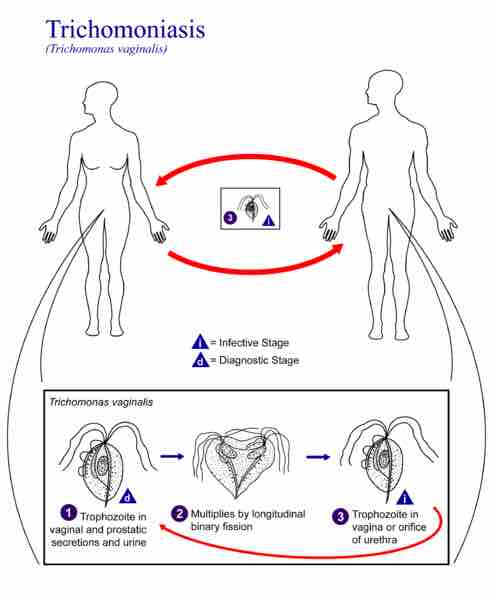Trichomoniasis, sometimes referred to as "trich", is a common cause of vaginitis. It is a sexually transmitted disease, and is caused by the single-celled protozoan parasite Trichomonas vaginalis producing mechanical stress on host cells and then ingesting cell fragments after cell deat . Trichomoniasis is primarily an infection of the urogenital tract; the most common site of infection is the urethra and the vagina in women. Typically, only women experience symptoms associated with Trichomonas infection .

Trichomoniasis vaginalis
Trichomoniasis is primarily an infection of the urogenital tract; the most common site of infection is the urethra and the vagina in women.

Micrograph showing Trichomoniasis
Micrograph showing a positive result for trichomoniasis. A trichomonas organism is seen on the top-right of the image.
Symptoms include inflammation of the cervix (cervicitis), urethra (urethritis), and vagina (vaginitis) which produces an itching or burning sensation. Discomfort may increase during intercourse and urination. There may also be a yellow-green, itchy, frothy, foul-smelling ("fishy" smell) vaginal discharge. In rare cases, lower abdominal pain can occur. Symptoms usually appear in women within 5 to 28 days of exposure. In many cases, men may hold the parasite for some years without any signs (dormant). Some sexual health specialists have stated that the condition can probably be carried in the vagina for years, despite standard tests being negative. While symptoms are most common in women, some men may temporarily exhibit symptoms such as an irritation inside the penis, mild discharge or slight burning after urination or ejaculation. Trichomoniasis is diagnosed by visually observing the trichomonads via a microscope. In women, the examiner collects the specimen during a pelvic examination by inserting a speculum into the vagina and then using a cotton-tipped applicator to collect the sample. The sample is then placed onto a microscopic slide and sent to a laboratory to be analyzed.